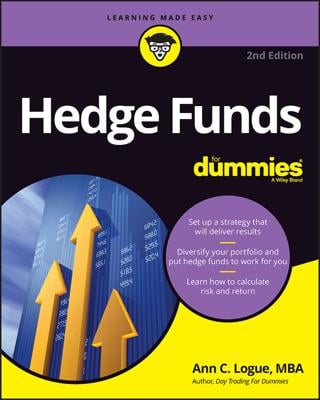Hedge funds are designed to reduce an investment risk (called hedging) while maintaining a good return on investment. You can sort hedge funds into two basic categories: absolute-return funds and directional funds. The following sections look at the differences between the two.
Hedge funds are small, private partnerships, and hedge fund managers can use a wide range of strategies to meet their risk and return goals. For these reasons, we can't recommend any funds or fund families to you, and we can't tell you that any one strategy will be appropriate for any one type of investment. That's the downside of being a sophisticated, accredited investor: You have to do a lot of work on your own!
Absolute-return funds
Sometimes called a "non-directional fund," an absolute-return fund is designed to generate a steady return no matter what the market is doing. An absolute-return fund has another moniker: a pure-alpha fund. In theory, the fund manager tries to remove all market risk in order to create a fund that doesn't vary with market performance. If the manager removes all the market risk, the fund's performance comes entirely from the manager's skill, which in academic terms is called alpha.
An absolute-return strategy is most appropriate for a conservative investor who wants low risk and is willing to give up some return in exchange.
Some people say that absolute-return funds generate a bond-like return because, like bonds, absolute-return funds have relatively steady but relatively low returns. The return target on an absolute-return fund is usually higher than the long-term rate of return on bonds, though. A typical absolute-return fund target is 8 to 10 percent, which is above the long-term rate of return on bonds and below the long-term rate of return on stocks.
Directional funds
Directional funds are hedge funds that don't hedge — at least not fully. Managers of directional funds maintain some exposure to the market, but they try to get higher-than-expected returns for the amount of risk that they take. Because directional funds maintain some exposure to the stock market, they're sometimes called beta funds and are said to have a stock-like return. A fund's returns may not be steady from year to year, but they're likely to be higher over the long run than the returns on an absolute-return fund.
A directional fund's return may be disproportionately larger than its risk, but the risk is still there. These funds can also swing wildly, giving a big return some years and plummeting big in others. Longer-term investors may not mind as long as the upward trend is positive.

